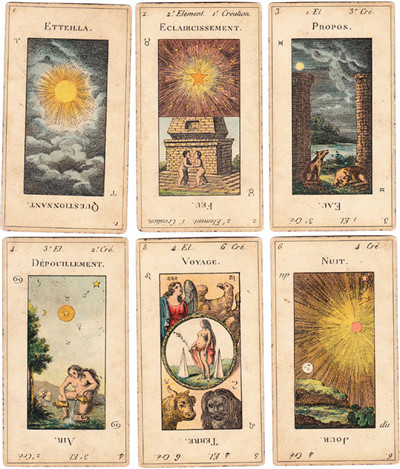While the tarot is the most widely known, it's just one type of deck used for divination; others include common playing cards and so-called oracle decks, a term encompassing all the other fortune-telling decks distinct from the traditional tarot. Etteilla eventually switched to using a traditional tarot deck, which he claimed held secret wisdom passed down from ancient Egypt. Etteilla's premise echoed the writings of Court de Gébelin, who allegedly recognized Egyptian symbols in tarot-card illustrations. Though hieroglyphics had not yet been deciphered (the Rosetta Stone was rediscovered in 1799), many European intellectuals in the late 18th century believed the religion and writings of ancient Egypt held major insights into human existence. By linking tarot imagery to Egyptian mysticism, they gave the cards greater credibility.
當塔羅牌已經廣為人知之后,它仍然不是唯一一種用于占卜的紙牌;其他的包括普通的撲克牌和一種叫做神諭卡的卡牌,那是一種綜合了其他所有占卜牌的特點而又和傳統塔羅牌截然不同的卡牌。“艾特拉”后來又發展成了現在所講的,其中蘊含著古埃及智慧的塔羅牌,Court de Gébelin從“艾特拉”中獲取了靈感,據說他從塔羅牌的插畫中辨認出了古老的埃及符號。雖然古埃及的象形文字直到現在都沒有被完全破譯(羅塞塔石碑在1799年才被發現),早在十八世紀晚期就有很多人相信古埃及的宗教和文化深遠地影響到了人類存續,通過把塔羅牌上的圖像和神秘的古埃及聯系起來,他們給塔羅牌賦予了更多的意義。
Building on Court de Gébelin's Egyptian connection, Etteilla claimed that tarot cards originated with the legendary Book of Thoth, which supposedly belonged to the Egyptian god of wisdom. According to Etteilla, the book was engraved by Thoth's priests into gold plates, providing the imagery for the first tarot deck. Drawing on these theories, Etteilla published his own deck in 1789—one of the first designed explicitly as a divination tool and eventually referred to as the Egyptian tarot.
在Court de Gébelin把塔羅牌和古埃及聯系起來之后,Alliette宣稱塔羅牌的起源來自代表古埃及智慧之神透特的圣書。據他所說,圣書被透特的祭司刻在黃金的薄片上,最初的塔羅牌圖案就來源于此。根據這些理論,Alliette在1789年出版了他的第一種明確用于占卜的牌,之后被稱作埃及塔羅牌。

A few of the cards from Etteilla's esoteric deck, reproduced by Grimaud in 1890.
1890年,Alliette的塔羅牌組。













